Under the weather or just feeling Flemish?
In honor of my 3rd year in attendance at the Janesville Renaissance Fair, I made myself a new outfit. Big surprise right.
This is 16th century Flemish based entirely on Reconstructing History's pattern 209 (Netherlandish Common woman), which I bought because I like the little jacket, then didn't get to making said jacket! Oh well. I also spent a lot of time looking at Aertsen & Bruegel paintings to make sure I got the details right, especially since I went into this not knowing a darned thing about 16th century Flemish clothing and only had a week to work.
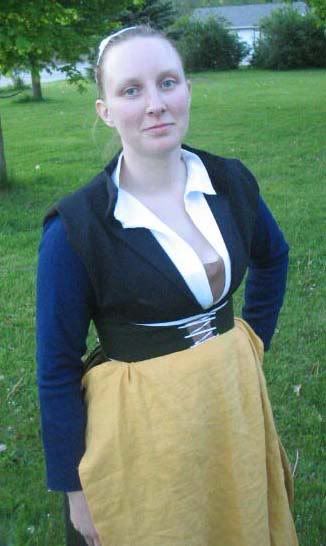
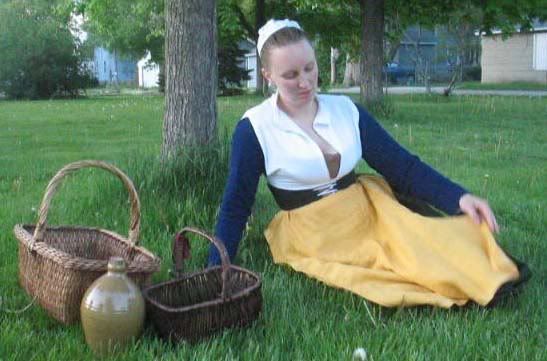 I'm wearing (from inside out), a linen/cotton blend smock, my 18th century stockings, one of my 18th century linen petticoats (the red one), a brown linen stomacher; lined & interlined with linen, a dark green wool kirtle, blue wool sleeves, white linen partlet, black wool partlet, yellow linen square ticked into a lace at my waist as an apron, white linen coif & my 18th century flat crowned straw hat. I wore my wooden shoes for the event and boy did people notice. I also learned that the wooden shoes while great on dirt & in the mud are terrible walking around in the Walmart!
I'm wearing (from inside out), a linen/cotton blend smock, my 18th century stockings, one of my 18th century linen petticoats (the red one), a brown linen stomacher; lined & interlined with linen, a dark green wool kirtle, blue wool sleeves, white linen partlet, black wool partlet, yellow linen square ticked into a lace at my waist as an apron, white linen coif & my 18th century flat crowned straw hat. I wore my wooden shoes for the event and boy did people notice. I also learned that the wooden shoes while great on dirt & in the mud are terrible walking around in the Walmart!
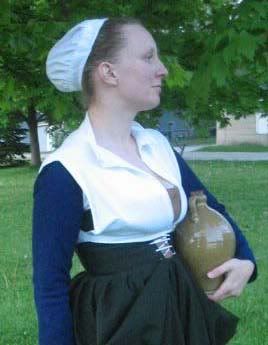
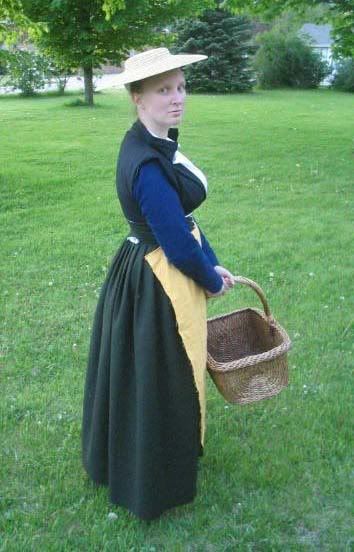

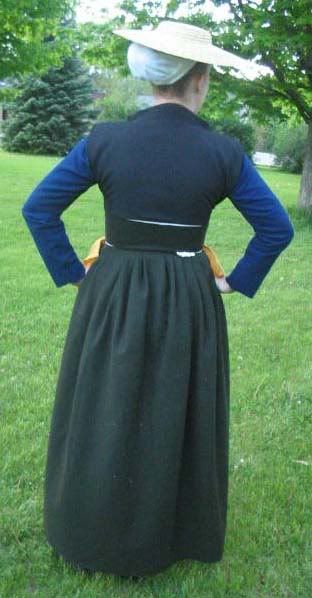 The kirtle laces up the center front with a thin cotton lacing cord. On either side of the opening I slipped in 2 pieces of half round reed for support (of the bust more than anything!) I just poked the lacing through the material since I didn't think that rings on either side would take the strain that I was putting it under to hold my shape with no other support. The linen stomacher pinned in the center front & that helped a lot too. But look at that profile! I'm still amazed that with no bra my bust still managed to be high & round. Who says dressing historical isn't sex.
The kirtle laces up the center front with a thin cotton lacing cord. On either side of the opening I slipped in 2 pieces of half round reed for support (of the bust more than anything!) I just poked the lacing through the material since I didn't think that rings on either side would take the strain that I was putting it under to hold my shape with no other support. The linen stomacher pinned in the center front & that helped a lot too. But look at that profile! I'm still amazed that with no bra my bust still managed to be high & round. Who says dressing historical isn't sex.
I got the kirtle wool from Hancock fabrics & it is the most beautiful forest green soft material ever! The black wool for the partlet was actually found in my local JoAnn's clearance section under spring suitings, as was the linen/cotton blend used for the smock.
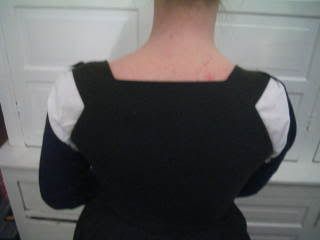 The back without partlets on. I could have set the straps a bit wider on the shoulders but I tend to have trouble with things falling off the edges when I do & I didn't want to risk any slipping. The most interesting thing is that the entire bodice is constructed from 1 rectangle of fabric! This is what it looks like without the straps attached to the back yet and an in progress picture. As it turned out the entire kirtle is hand sewn. The bodice construction meant that hand sewing was easiest so I figured, why not, and attached the skirt by hand as well. I was a little worried that it wouldn't hold up but then remembered that L's blue gown is hand sewn & held up fine so why was I to worry. I certainly don't "wear" my clothing as hard as a 7 year old does.
The back without partlets on. I could have set the straps a bit wider on the shoulders but I tend to have trouble with things falling off the edges when I do & I didn't want to risk any slipping. The most interesting thing is that the entire bodice is constructed from 1 rectangle of fabric! This is what it looks like without the straps attached to the back yet and an in progress picture. As it turned out the entire kirtle is hand sewn. The bodice construction meant that hand sewing was easiest so I figured, why not, and attached the skirt by hand as well. I was a little worried that it wouldn't hold up but then remembered that L's blue gown is hand sewn & held up fine so why was I to worry. I certainly don't "wear" my clothing as hard as a 7 year old does.
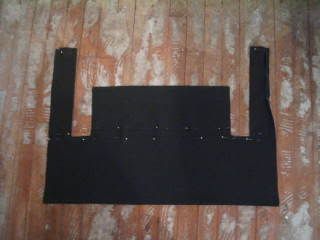
 The fair was fun as usual, although too short! I got to see friends that I only see once a year, drank more root beer than a normal person should, saw 3 watermelons get shot to bits & enjoyed authentic 16th century gingerbread. Luckily I should get to wear this outfit again when we go to the bigger statewide renaissance fair in July. Hopefully by then I will have gotten around to making the jacket!
The fair was fun as usual, although too short! I got to see friends that I only see once a year, drank more root beer than a normal person should, saw 3 watermelons get shot to bits & enjoyed authentic 16th century gingerbread. Luckily I should get to wear this outfit again when we go to the bigger statewide renaissance fair in July. Hopefully by then I will have gotten around to making the jacket!
Thanks for looking! Now back to my regularly scheduled 18th century work.
This is 16th century Flemish based entirely on Reconstructing History's pattern 209 (Netherlandish Common woman), which I bought because I like the little jacket, then didn't get to making said jacket! Oh well. I also spent a lot of time looking at Aertsen & Bruegel paintings to make sure I got the details right, especially since I went into this not knowing a darned thing about 16th century Flemish clothing and only had a week to work.

 I'm wearing (from inside out), a linen/cotton blend smock, my 18th century stockings, one of my 18th century linen petticoats (the red one), a brown linen stomacher; lined & interlined with linen, a dark green wool kirtle, blue wool sleeves, white linen partlet, black wool partlet, yellow linen square ticked into a lace at my waist as an apron, white linen coif & my 18th century flat crowned straw hat. I wore my wooden shoes for the event and boy did people notice. I also learned that the wooden shoes while great on dirt & in the mud are terrible walking around in the Walmart!
I'm wearing (from inside out), a linen/cotton blend smock, my 18th century stockings, one of my 18th century linen petticoats (the red one), a brown linen stomacher; lined & interlined with linen, a dark green wool kirtle, blue wool sleeves, white linen partlet, black wool partlet, yellow linen square ticked into a lace at my waist as an apron, white linen coif & my 18th century flat crowned straw hat. I wore my wooden shoes for the event and boy did people notice. I also learned that the wooden shoes while great on dirt & in the mud are terrible walking around in the Walmart!


 The kirtle laces up the center front with a thin cotton lacing cord. On either side of the opening I slipped in 2 pieces of half round reed for support (of the bust more than anything!) I just poked the lacing through the material since I didn't think that rings on either side would take the strain that I was putting it under to hold my shape with no other support. The linen stomacher pinned in the center front & that helped a lot too. But look at that profile! I'm still amazed that with no bra my bust still managed to be high & round. Who says dressing historical isn't sex.
The kirtle laces up the center front with a thin cotton lacing cord. On either side of the opening I slipped in 2 pieces of half round reed for support (of the bust more than anything!) I just poked the lacing through the material since I didn't think that rings on either side would take the strain that I was putting it under to hold my shape with no other support. The linen stomacher pinned in the center front & that helped a lot too. But look at that profile! I'm still amazed that with no bra my bust still managed to be high & round. Who says dressing historical isn't sex.I got the kirtle wool from Hancock fabrics & it is the most beautiful forest green soft material ever! The black wool for the partlet was actually found in my local JoAnn's clearance section under spring suitings, as was the linen/cotton blend used for the smock.
 The back without partlets on. I could have set the straps a bit wider on the shoulders but I tend to have trouble with things falling off the edges when I do & I didn't want to risk any slipping. The most interesting thing is that the entire bodice is constructed from 1 rectangle of fabric! This is what it looks like without the straps attached to the back yet and an in progress picture. As it turned out the entire kirtle is hand sewn. The bodice construction meant that hand sewing was easiest so I figured, why not, and attached the skirt by hand as well. I was a little worried that it wouldn't hold up but then remembered that L's blue gown is hand sewn & held up fine so why was I to worry. I certainly don't "wear" my clothing as hard as a 7 year old does.
The back without partlets on. I could have set the straps a bit wider on the shoulders but I tend to have trouble with things falling off the edges when I do & I didn't want to risk any slipping. The most interesting thing is that the entire bodice is constructed from 1 rectangle of fabric! This is what it looks like without the straps attached to the back yet and an in progress picture. As it turned out the entire kirtle is hand sewn. The bodice construction meant that hand sewing was easiest so I figured, why not, and attached the skirt by hand as well. I was a little worried that it wouldn't hold up but then remembered that L's blue gown is hand sewn & held up fine so why was I to worry. I certainly don't "wear" my clothing as hard as a 7 year old does.
 The fair was fun as usual, although too short! I got to see friends that I only see once a year, drank more root beer than a normal person should, saw 3 watermelons get shot to bits & enjoyed authentic 16th century gingerbread. Luckily I should get to wear this outfit again when we go to the bigger statewide renaissance fair in July. Hopefully by then I will have gotten around to making the jacket!
The fair was fun as usual, although too short! I got to see friends that I only see once a year, drank more root beer than a normal person should, saw 3 watermelons get shot to bits & enjoyed authentic 16th century gingerbread. Luckily I should get to wear this outfit again when we go to the bigger statewide renaissance fair in July. Hopefully by then I will have gotten around to making the jacket!Thanks for looking! Now back to my regularly scheduled 18th century work.
Labels: 16th Century, Women





